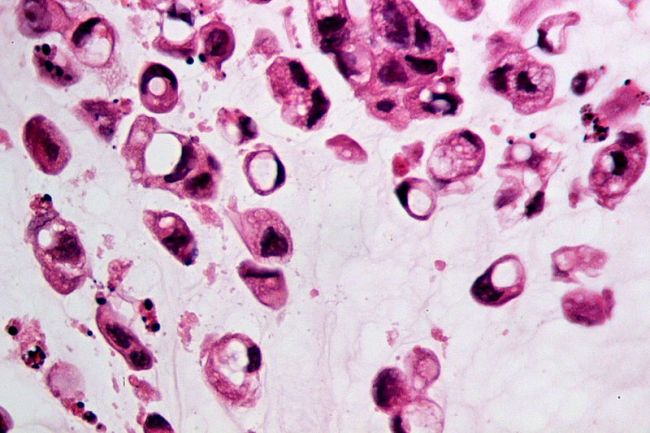Like so many behind-the-scenes gaffers and stagehands, cell adhesion proteins ensure structural integrity and thus proper functioning of all our cells. Cell adhesion may not be one of the more showy or glamorous cellular processes, but it is no less vital to organism survival. After all, what would happen if we suddenly lost all our cell adhesion molecules? Would we drop into a pile of cells on the floor? Could we have ever become more than a loose collection of dividing cells? Today, we explore the role of CDH1, a gene without which, none of it would have been possible.

3D structure of E-cadherin, encoded by gene CDH1. (Image by EMW, CC-BY-SA)
Encoded by the gene CDH1, epithelial cadherin (E-cadherin) is a transmembrane protein required for cell-cell adhesion. When expressed on both membranes of neighboring cells, E-cadherins bind together to form the tight adherens junctions that join cells together in an organized tissue.1 To explain how critical this function is, let’s start at the very beginning:
1) Sperm meets egg.
2) The fertilized egg travels down the fallopian tube, all the while dividing… and dividing…
3) The embryo, now a ball of dividing cells (around a total of 32 cells), starts to compact into a tighter ball of cells—a developmental event that wouldn’t be possible without CDH1! Luckily, there’s enough maternal E-cadherin remaining to allow for this cell-cell adhesion.2
4) The embryo then begins to differentiate into an inner cell mass and outer cell layer (trophectoderm), which later becomes the placenta. However, without any E-cadherin, trophectoderm fails to develop; ultimately, the embryo cannot implant in the uterus, and dies from defect in placenta formation.34
And so, even as a small mass of cells, life could not proceed without CDH1.
In some families though, CDH1 mutations have been passed down from generation to generation. For heterozygous carriers, there is enough functional E-cadherin that developmental problems are avoided. However, lifetime risk of developing gastric cancer is over 80% by age 80.5 Specifically, mutations in CDH1 can cause hereditary diffuse gastric cancer, as well as increased risk for lobular breast cancer.6

Signet ring cells are a hallmark characteristic of hereditary diffuse gastric cancer (among other cancers). These cells are named for their resemblance to signet rings; in each cell, a large vacuole of mucin (resembling the empty finger hole of a ring) pushes the nucleus of the cell to the edge (the darker colored label resembling the flat top of a signet ring). (Image by Patho, CC-BY-SA)
In tumors, down-regulation of CDH1 can promote metastasis; loss of E-cadherin not only disrupts cell-cell adhesion between tumor cells, but also causes downstream transcriptional changes that increase cellular motility and invasiveness.7 This tendency towards metastasis, when combined with the difficulty of early detection and poor outcomes of gastric cancer, means that occasionally, patients with CDH1 mutations (even those without cancer symptoms) undergo prophylactic surgery to remove the entire stomach. To read more about what it’s like to live without a stomach, click here and check out this incredible network of CDH1 bloggers!
As a prominent tumor (and invasion) suppressor gene, CDH1 is most often studied for its involvement in cancer. However, recent research suggests another emerging role in development—specifically, in the formation of neural circuits. As a co-activator in the APC/C complex, Cdh1 targets proteins for degradation; while this APC/C-Cdh1 complex is best known for its maintenance of cell cycle progression, new evidence indicates that it also affects axon growth, synaptic differentiation, and neuronal survival.891011 Therefore, to better understand the full extent to which CDH1 guides and directs cellular processes, it’s critical to characterize its role during both development and cancer. After all, (if you’ve learned two new things from this, it ought to be…) while a person can manage without a stomach, we certainly can’t do without any CDH1!
References:
- Onder TT, Gupta PB, Mani SA, Yang J, Lander ES, Weinberg RA. (2008) Loss of E-cadherin promotes metastasis via multiple downstream transcriptional pathways. Cancer Res. 68(10):3645-54. doi: 10.1158/0008-5472.CAN-07-2938. [↩]
- Riethmacher D, Brinkmann V, Birchmeier C. (1995) A targeted mutation in the mouse E-cadherin gene results in defective preimplantation development. Proc Natl Acad Sci U S A. 92(3):855-9. [↩]
- Larue L, Ohsugi M, Hirchenhain J, Kemler R. (1994) E-cadherin null mutant embryos fail to form a trophectoderm epithelium. Proc Natl Acad Sci U S A. 91(17):8263-7. [↩]
- García-Higuera I, Manchado E, Dubus P, Cañamero M, Méndez J, Moreno S, Malumbres M. (2008) Genomic stability and tumour suppression by the APC/C cofactor Cdh1. Nat Cell Biol. 10(7):802-11. doi: 10.1038/ncb1742. [↩]
- Oliveira C, Pinheiro H, Figueiredo J, Seruca R, Carneiro F. (2013) E-cadherin alterations in hereditary disorders with emphasis on hereditary diffuse gastric cancer. Prog Mol Biol Transl Sci. 116:337-59. doi: 10.1016/B978-0-12-394311-8.00015-7. [↩]
- Oliveira C, Pinheiro H, Figueiredo J, Seruca R, Carneiro F. (2013) E-cadherin alterations in hereditary disorders with emphasis on hereditary diffuse gastric cancer. Prog Mol Biol Transl Sci. 116:337-59. doi: 10.1016/B978-0-12-394311-8.00015-7. [↩]
- Onder TT, Gupta PB, Mani SA, Yang J, Lander ES, Weinberg RA. (2008) Loss of E-cadherin promotes metastasis via multiple downstream transcriptional pathways. Cancer Res. 68(10):3645-54. doi: 10.1158/0008-5472.CAN-07-2938. [↩]
- Puram SV, Bonni A. (2011) Novel functions for the anaphase-promoting complex in neurobiology.Semin Cell Dev Biol. 22(6):586-94. doi: 10.1016/j.semcdb.2011.03.006. [↩]
- Hu D, Qiao X, Wu G, Wan Y. (2011) The emerging role of APC/CCdh1 in development. Semin Cell Dev Biol. 22(6):579-85. doi: 10.1016/j.semcdb.2011.03.012. [↩]
- Eguren M, Manchado E, Malumbres M. (2011) Non-mitotic functions of the Anaphase-Promoting Complex. Semin Cell Dev Biol. 22(6):572-8. doi: 10.1016/j.semcdb.2011.03.010. [↩]
- Almeida A. (2012) Regulation of APC/C-Cdh1 and its function in neuronal survival. Mol Neurobiol. 46(3):547-54. doi: 10.1007/s12035-012-8309-2. [↩]

Awesome article melissa! keep em’ coming.
Thanks Gip! Kerin and I will be churning them out every week! At this rate, we’ll finish the entire human genome, in say, about 400 years 🙂